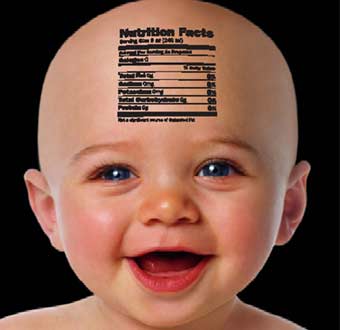 We all know it is important to read labels when grocery shopping for our babies and children. But, do you know exactly what to look-out for and why?
We all know it is important to read labels when grocery shopping for our babies and children. But, do you know exactly what to look-out for and why?
Theresa Kiene gives us some great advice on what to keep out of our grocery carts, and insight on some SAFE ALTERNATIVES too.
These 4 DANGERS TO YOUR CHILD’S BRAIN – Begin In Your Grocery Cart. And if you know what to look for, you will nourish the sweetness that your child was naturally born with….
Do you ever wonder how Jello gets its pretty colors? Or how the taste of vanilla can exist in food that doesn’t contain vanilla beans? Additives and chemicals are added to our everyday foods and beverages and most have nothing to do with nutritional value. They exist to fulfill consumer’s expectation of perfection.
We know that Mother Nature may not produce a perfect fruit or vegetable so we keep them unblemished with the use of fungicides, pesticides and herbicides. With the continued high demand from consumers for meals that are easy to prepare and taste good, the industry of food additives in the category of flavorings and flavor enhancers is expected to top $1.46 billion this year.
Dangerous Additives in Our Babies and Children’s Foods
Food additives are not new (originally they were made from coal tar oil) and children have been eating them for decades. So why do we care about them now?
Today our children are exposed to additives and chemicals everyday all day. Instead of the occasional candy, or special occasion pink cupcakes, children growing up in the United States are digesting chemicals from breakfast until bedtime. Multi-colored toothpaste, colored breakfast cereals, artificial whip toppings, bubble gum, liquid medicine and highly processed convenience foods in lunchboxes (can you say Lunchables?) More children are drinking soft drinks with artificial color, flavor, caffeine and aspartame. The more they have the more they crave and for a tired parent, sometimes the path of least resistance becomes the choice.
More importantly, pesticides, hormones and synthetic food additives have been shown to affect brain development, behavior and learning abilities in children. What you put in your shopping cart is more important that ever!
FOOD DYES
Listed on the ingredients label as “Yellow No. 5”, “Red #3”, etc. Dyes are used primarily to make food appear fresher than it is, or in the case of many foods made for children, to attract them with bright colors. They are used in breakfast cereals, drinks, candy, bakery goods, puddings, gelatin desserts, just to name a few. Instead, look for carrots and beets as natural coloring agents on the label.
ARTIFICIAL FLAVORINGS
Are made up of hundreds of combinations of chemicals, both natural and synthetic. A popular flavoring agent is “vanillin” also listed as “vanilla flavoring” This flavoring agent is made from the waste product of paper mills. Instead, look for “pure vanilla” on the label. MSG, salt and sodium containing agents are popular food additives. MSG has been linked to brain damage and infertility in laboratory animals and many people who eat MSG complain of headaches, chest pains and numbness. It’s primarily used to intensify flavor in meats, condiments, pickles, soups, candy and baked goods.
PRESERVATIVES
There are about one hundred preservatives which are used to prevent food from going “bad”. BHA, BHT and TBHQ are three commonly used preservatives. They may also be listed as “anti-oxidants” because they prevent the fats in food from “oxidizing” or spoiling. There are natural and beneficial anti-oxidants but they are more expensive than the synthetic versions that are currently widely used. You can find them in beverages, ice cream, candy, baked goods, soup bases, potatoes, breakfast cereals, dry mixes, enriched rice, animal fats and shortenings containing animal fats. These preservatives can cause allergic reactions and have been known to affect kidney and liver functions, brain function and may also convert other ingested substances into cancer-causing additives.
Nitrates, nitrites and sulfites, sodium benzoate, calcium propionate and citric acid are preservatives that trigger terrible symptoms in allergy sensitive kids, but for some they are deadly. Nitrates and Nitrites are used as a color fixative in cured meats, and studies have linked them to cancer. Sulfites are used for their anti-browning effects and to keep fruits and vegetables crisp longer.
SWEETENERS
Refined starches, high-fructose corn syrup and all artificial sweeteners (NutraSweet, Equal, Sweet’n Low, Sucralose, Acesulfame-K) not only rob your children of their health, but artificial sweeteners have been linked to brain damage, MS, Lupus and other central nervous disorders. Excessive sugar intake in children is also a contributing factor to our current childhood obesity epidemic.
As the primary grocery shopper, you are the most important person in your family’s health. By reading labels and selecting wisely, you can protect your family and affect the sales of more wholesome foods



